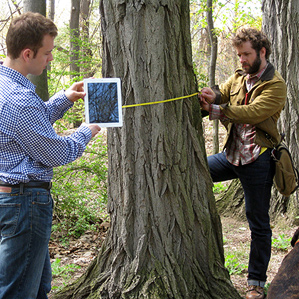The App Craze Branches into Forestry
In a small office near Central Square in Cambridge, Massachusetts, just across from Starbucks, is a small startup with a big idea for balancing biodiversity with business. SilviaTerra has developed better ways to identify and quantify the trees in forests, using smartphones and satellite imagery. The company’s goal is to help landowners, conservation groups, and timber companies manage their inventory and preserve valuable natural habitats.

From the Amazon and Indonesia to temperate regions such as the Olympic Peninsula and Russia, forests are among the planet’s most biologically diverse and valuable places. The World Wildlife Fund, which estimates that we are losing dozens of football fields of forest per minute, describes deforestation as “the biggest threat to biodiversity and climatic stability.”
Conducting a forest inventory is currently laborious work. “They’re literally sending guys out to the woods with paper and pencil,” says SilviaTerra cofounder Max Uhlenhuth. “They’ll go measure, in one tenth of an acre area, the sizes and species of trees they have; you have to do a lot of random samples to make sure you cover all that variance.”
Uhlenhuth and cofounder Zack Parisa, who came up with the idea for the startup when he was a graduate student at Yale’s forestry school, have two products that promise to update current methods. The first, called TimberScout, is software that detects forest changes by analyzing satellite imagery, which can usually be obtained through a contracting service. The tool measures variation using machine learning algorithms and customized software.
SilviaTerra’s second product, PlotHound, is a free Android and iOS app that helps professional foresters keep track of forest inventory. Information recorded during a plot survey is automatically uploaded, and the app can tell the forester where to go to measure the most critical trees to get an accurate picture of the overall plot. The app is currently used by several thousand foresters across the United States, and SilviaTerra uses the collected information to improve its algorithms. “As we collect more information and build a data library, then by updating the remotely sensed imagery, we’ll have [complete] coverage of the U.S.,” says Parisa, who is SilviaTerra’s CEO.
Alex Finkral, senior forester at the Forestland Group, the fifth-largest forestry company in the United States, believes that the technology will be the “a big step for estimating the quantity of trees and value of trees.”
The Forestland Group is using SilviaTerra in a pilot program that will compare its technology with traditional techniques. Large landowners with forests, Finkral says, have a constantly shifting schedule of inventories, and updating inventory estimates is expensive. “With tens and hundreds of thousands of acres, you don’t need to send an army of people to sample,” he says.
Cataloguing forests is useful for a range of purposes. Earlier in 2013, SilviaTerra started work with a conservation group with land near Mount Kenya to assess how reforestation efforts in communities across a million acres have affected conservation efforts focusing on five animal species.
Parisa says his original inspiration came when he tried to inventory Armenia’s national forests and began wondering how he’d evaluate biodiversity in Peru. Ultimately, he hopes that the forest information collected by SilviaTerra can inform policy debates about issues like the feasibility of carbon markets or how to maximize deer populations for hunting. In fact, with satellites, software, smartphones, iPads, and apps, he’ll be counting on it.
Keep Reading
Most Popular
Large language models can do jaw-dropping things. But nobody knows exactly why.
And that's a problem. Figuring it out is one of the biggest scientific puzzles of our time and a crucial step towards controlling more powerful future models.
The problem with plug-in hybrids? Their drivers.
Plug-in hybrids are often sold as a transition to EVs, but new data from Europe shows we’re still underestimating the emissions they produce.
Google DeepMind’s new generative model makes Super Mario–like games from scratch
Genie learns how to control games by watching hours and hours of video. It could help train next-gen robots too.
How scientists traced a mysterious covid case back to six toilets
When wastewater surveillance turns into a hunt for a single infected individual, the ethics get tricky.
Stay connected
Get the latest updates from
MIT Technology Review
Discover special offers, top stories, upcoming events, and more.